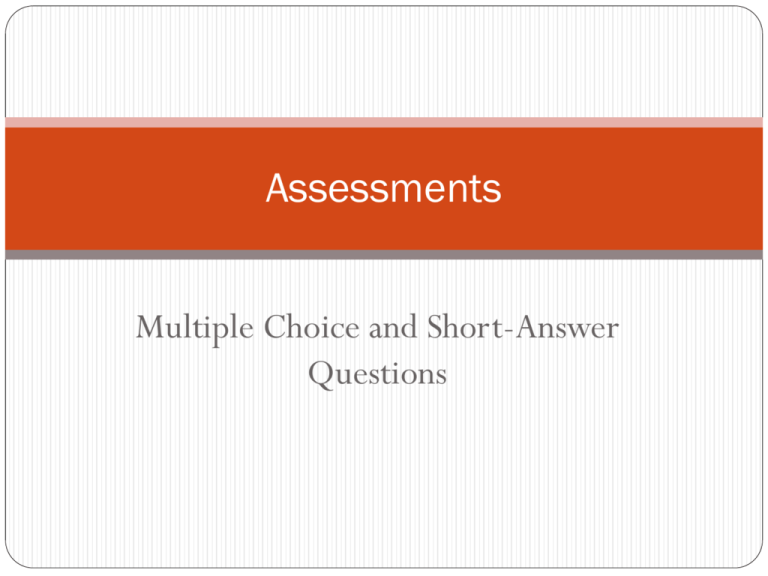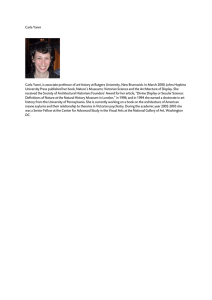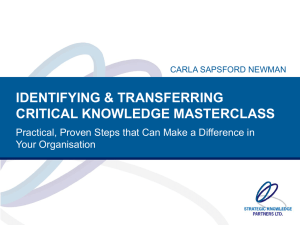Assessments - Health IT Education
advertisement

Assessments Multiple Choice and Short-Answer Questions Updates Updating templates for HIT cert/program approval and dissemination; will send out on Wednesday Created templates for scenarios and other learning activities; will send those out this afternoon Topics Comparison of different types of multiple choice and short- answer questions Incorporation of mini-scenarios into assessments The right assessment questions for the desired learning outcomes Example #1: Multiple choice a. Which organization began with a focus on management engineering? a) AMIA b) HIMSS c) AHIMA d) NAHIT e) JHITA b. Studies have identified which of the following as a way to reduce medical error? a. reduce reliance on memory b. improve access to information so that decisions aren’t made based on incomplete data. c. avoid hand-written orders d. all of the above.* Example #2: Short answer question a. What is the definition of a hospitalist? b. How has the role of hospitalist affected physician-patient interaction in hospitals? Multiple choice meets scenario BEFORE: Which of the following is the most secure way to carry sensitive data? A. On a laptop B. On a USB drive chained to your wrist C. On a CD titled “The Chipmunks Sing Disco Duck” Feedback for incorrect answer: Incorrect.Try again. From Cathy Moore’s site http://blog.cathy-moore.com/ Multiple choice meets scenario AFTER: Bob wants to work on the salary data at home. He has a long commute on a train. How should he carry the data with him? A. On his laptop B. On a USB drive chained to his wrist C. On a CD titled “The Chipmunks Sing Disco Duck” Feedback for A: Bob falls asleep during the commute, and a thief steals his laptop and sells the data. Try again. Feedback for B: Bob falls asleep during the commute. A thief sits next to him, plugs his USB drive into his laptop while Bob is unconscious, and later sells the data.Try again. Feedback for C: Bob falls asleep during the commute, and a thief steals all his belongings.The thief breaks the CD into pieces in disgust and no one ever sees the data.This is the best choice. Short-answer question meets scenario 1. Since you work in healthcare, your grandmother has asked you to help her decide if your grandfather, who is terminally ill, should go to a nursing home, or to hospice, or just stay at home and have home health services take care of him. How will you respond to her? In your response, cite differences among the services provided and your selection rationale. In response to this question, you should describe the differences between these services, the purpose they serve and their scope of service. Feedback Nursing home: may provide skilled care which requires the credentials of a registered nurse on an around-the-clock basis. It may also provide an intermediate level of care that provides care primarily reliant on the capabilities of the licensed practical nurse. This care may include medication administration, ambulating, checking vital signs, and other nursing and supportive duties. Hospice programs provide supportive services to persons who are dying and whose doctors have determined that their expected life span is 6 months or less. In the hospice program, the patient agrees to forego major medical interventions for the terminal illness, is kept comfortable and pain-free to the extent possible, and the patient and family are supported by the hospice team as they face the death of the family member. Home health services are those that are provided in the home of the patient. These may involve visits by registered nurses, licensed practical nurses, nurse aides, or other supportive personnel. A limited level of physician therapy may be provided, and if the patient needs oxygen or medical devices that can be administered in the home, these will be provided based upon a doctor’s order. For the terminally ill patient, home health services may provide adequate care in the early stages of the terminal diagnosis. However as the patient’s condition progresses, the family may find that hospice services are needed if the grandfather determines that he does not want any “heroic measures” taken to extend his life. If he cannot be supported at home adequately, he may be admitted to a nursing home and be cared for by the staff there as well as hospice workers Short-answer question meets scenario You’ve seen a blog post by a physician who thinks that the benefits of EHRs are overrated and that they’re too costly. He also says that he didn’t become a doctor in order to spend half his time typing at a computer. Convince him of the current and future benefits of healthcare providers adopting EHR systems. Choosing the right assessment item and feedback for the desired learning outcome Example #1: Training for sales team Carla, a sales person, is meeting with Amit, a new customer. She shows him a megawidget. “You’ll love this megawidget,” Carla says. “I don’t want a megawidget,” Amit says. “I came in here for a microwidget.” What is this an example of? a. Product Boundary Issues b. Customer Misvetting c. Courageous Upselling Example #2: Training for sales team Carla, a sales person, is meeting with Amit, a new customer. “I might be interested in your J-12 microwidget,” Amit says. “At 79 wigabits, it has enough power for paramatizing. But I’ve read that it runs hot.” What should Carla say? a. “Are you referring to the Widget World review?” b. “Actually, the J-12 has only 60 wigabits. I think you’d need the K-77.” c. “Our studies have never shown any heat issues with the J-12. Would you like to see the test results?” Feedback options Let’s say the learner chooses an incorrect option C above—they think Carla should tell Amit, “Our studies have never shown any heat issues with the J-12. Would you like to see the test results?” Feedback option #1 Incorrect. Try again. Feedback option #2 While this response won’t derail the sales conversation, it could make Carla seem defensive and possibly increase Amit’s skepticism. It would be better for Carla to show that she’s familiar with what the industry is saying about our widgets. Try again. Feedback option #3 “I’m not surprised that your studies don’t show any problems,” Amit says, sounding a little annoyed. “But Widget World does rigorous, independent testing, and they found heat issues. What can you say about their results?” Different angle on assessment 1. Create a visual representation of the different elements of care described in Chapter 3, including a brief description of and one example for each. [Feel free to create just a basic chart using something such as MS Word, or explore other mapping tools http://www.lifehack.org/articles/technology/11-freemind-mapping-applications-web-services.html; http://www.mindomo.com] Tips for Writing Effective Questions Use clear, precise, simple language Do not introduce brand new information in the question Include instructions on how to answer question if there is room for interpretation Remove ambiguity Tortuous syntax Unfamiliar vocabulary Double negatives “when should you not reject…?” Avoid Common Test Mistakes Avoid asking absolute questions (all, every, entirely, everybody, completely, always, never…) Vary your pattern Ensure that articles or other grammatical elements in the question don’t point toward the correct answer Other tips?




